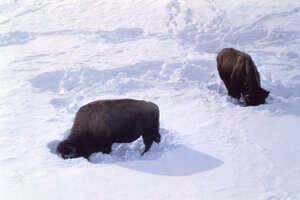Yellowstone bison fleeing impending supervolcano? No.
Yellowstone bison are responding to a much deeper instinct, say Yellowstone officials.

Yellowstone bison in snow at Oxbow Creek. With the huge muscles of their neck and shoulders, bison can use their enormous heads as snowplows, pushing snow away so they can forage beneath.
Courtesy of Tom McHugh/Yellowstone National Park/National Park Service
A viral video titled "ALERT! Yellowstone Buffalo Running for Their Lives!" has attracted over 1 million page views and has prompted hundreds of anxious inquiries via Facebook, Twitter, email, and phone calls to park officials.
The video shows a small herd of bison (their correct name, though "buffalo" persists) cantering down a paved road in Yellowstone National Park. Though park officials have noted that these two dozen or so bison are actually running deeper into the park, not away from it, it's true that many of Yellowstone's 4,600 bison are outside the park right now.
Why? Not because of Sunday's 4.8-magnitude earthquake, which was Yellowstone's biggest quake in decades but is still just one of the 1,000 to 3,000 temblors the park sees each year. And it's not, as the caption to the video suggests, because the supervolcano underlying Yellowstone's hundreds of hot springs and fumaroles is about to erupt catastrophically. Bison – and elk, and white-tail deer, and black-tail deer – leave the park in the springtime for a very simple reason, says Yellowstone's Public Affairs Chief Al Nash: food.
"Bison are indeed walking out to places that their herd memory tells them may offer a chance of food that's easier to get at and perhaps fresh green food, but what we also know is, as the snow melts and things green up at elevation, they'll walk back in," he says.
"Bison are migratory animals," explains Mr. Nash. "They move all the time. Sometimes they're fast, sometimes they're slow. But this time of year, although it may start to look like spring in some parts of the United States, it doesn't in the interior of Yellowstone," where the snow is still many feet deep. Bison can shove aside deep snow with the massive muscles in their necks and shoulders, but they're not averse to easier meals, he says.
"Instinctively, they know that there are lower-elevation areas outside the park where spring occurs earlier, and bison will migrate from the higher-elevation interior of the park to lower-elevation areas outside the park, in search of food that's easier to eat."
Not only is the snow thinner on the ground at lower elevations – and in some patches, melted completely – but new life is starting to grow, says Nash. "Things are starting to green up at those lower elevations. So yes, there are bison leaving the park. That video does not illustrate that. They've been doing this type of migration for millennia. It's not anything new or unusual."
Migrating bison are easier to spot than smaller grazers for a couple reasons, says Nash. For one thing, of course, their sheer size and dark color make them dramatically visible, especially against a blanket of snow. "A bison doesn't melt into the landscape like even elk do," says Nash.
Another factor, he says, is that elk and deer will migrate across a broad area, but bison follow river valleys – which is where Yellowstone placed many of its roadways. So the bison are simply closer to the tourists.
Is Yellowstone sitting on top of a massive supervolcano? Of course, laughs Nash. That giant, shallow plume of magma "results in the unique features people have protected and come to see. Those processes are why we have geysers and hot springs and mud pots."
This isn't the first time people have worried that they've found the smoking gun pointing to an impending eruption, he says. "This is one of the best-monitored locations on the face of the Earth." With the enormous array of seismographs, GPS units, and borehole strain meters producing a constant flow of data, it's inevitable that some instrument will occasionally throw a spike once in a while, he says. When one data point isn't substantiated by any of the other equipment nearby, scientists know to dismiss it as an anomaly, as easily ignored as static on a phone call. But some alarmists will grab that one piece of data and trumpet it as proof of the impending Big One, says Nash.
"I'm glad that people are so interested in Yellowstone, but if they really want to know more about the geology, our website is a great place to learn, the Yellowstone Volcano Observatory website has some great information, and more importantly, get in the car and come on out this summer!" he says.
"We live here. We work here. We're not afraid. We're excited about the many things that happen here in Yellowstone, and we want to share it with the public."

